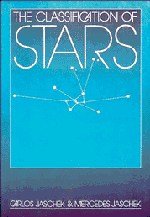6 - Comparison of classification methods
Published online by Cambridge University Press: 04 April 2011
Summary
Having seen in some detail spectroscopic and photometric classification methods, we shall compare them in this chapter. We shall examine first their ‘problem solving capability’ and ‘information content’. Finally we shall discuss the relation between classification and physical parameters. (For more details, see Jaschek 1982.)
Problem solving capability
In the chapter on spectral classification we have seen that in the Yerkes system there are two parameters, according to which stars can be arranged. If a star cannot be assigned a unique place in the scheme, it is called ‘peculiar’. We have also seen that in some cases abbreviations are needed for stars with varying degrees of rotation and that in some cases magnetic fields can be detected by the inspection of spectrograms. Therefore the list of parameters which can be ascertained from spectrograms is:
spectral type
luminosity class
spectral peculiarity
rotation
magnetic field.
Without going into details we may say that the spectral type corresponds to stellar surface temperature, luminosity class to stellar luminosity and spectral peculiarity to either abnormal atmospheric structures or anomalies in the abundance of chemical elements.
Our next question is whether these parameters can only be determined spectroscopically, or if photometry is able to do the same or better. This is a crucial question because it will determine the choice of instrumentation to attack a given problem.
- Type
- Chapter
- Information
- The Classification of Stars , pp. 93 - 99Publisher: Cambridge University PressPrint publication year: 1987



